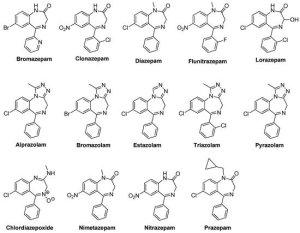
Classification and properties of benzodiazepines
These substances produce a wide variety of diverse effects, which include sedation, drowsiness, decreased anxiety, skeletal muscle relaxation, amnesia (forgetting situations from the administration of a substance) and anticonvulsant activity.
Despite the fact that all benzodiazepines (BDZ) have similar effects, there are differences in the selectivity with which each of them causes some of the previously mentioned effects.
Its clinical use varies depending on the structure of the benzodiazepine, the nature of the R groups at positions 1, 2, 5 and 7, and the main variables characterizing the drug in question.
However, the depth of the effects depends on the dose, and as it increases, signs of sedation, drowsiness, and even coma appear.
The first molecule of this type was produced by chlordiazepoxide in 1934 by Henrik Leo Stembach, but due to the Second World War it was introduced into medical practice only in the 1950s.
In the 1960s, Stembach himself began the production of benzodiazepines at the pharmaceutical company Hofmann-La Roche, which led to the rapid development of so-called “small tranquilizers.”
From a chemical point of view, benzodiazepines can be divided into two groups: simple 1,4-benzodiazepines (such as diazepam) and heterocyclic 1,4-benzodiazepines (such as alprazolam). Currently, a large number of BDZ have been synthesized, many of which have been tested, and only a few of them are used in clinical practice.
Its extraordinary popularity is based on its ability to reduce anxiety (defined as anxiety in the absence of a real object that directly causes it) without interfering too much with other functions related to the state of consciousness.
However, all BDZ have sedative and hypnotic effects, properties that have led to their widespread use instead of barbiturates. Some of them are also used for short periods of time as muscle relaxants.

1. Classification of benzodiazepines
For greater therapeutic benefit, benzodiazepines are classified according to their plasma half-life and pharmacological activity.
Thus, in this work, the main purpose of which is the chemical synthesis of hypnotics and sedatives, we will mention the classification of BDZ based on the plasma half-life, leaving for the specialized literature an additional classification according to the pharmacological activity of the same.
2. Synthesis of benzodiazepines
Depending on the structure of the resulting benzodiazepine, a specific synthesis scheme can be outlined, but in almost all of them it is necessary to spend a lot of time preparing the intermediate.:
Therefore, this section will begin by demonstrating various alternatives for the retro-synthetic analysis of this mediator, which will lead to various options for its synthesis.
Therefore, having established various alternatives that do not exhaust all possibilities for obtaining an intermediate molecule common to most benzodiazepines, we propose a scheme for the synthesis of benzodiazepines indicated in the previously described classification based on simple and affordable materials.

Synthesis of klobazam . Klobazam is a benzodiazepine drug that has been marketed as an anxiolytic since 1975 and as an anticonvulsant since 1984. It is also approved for complementary treatment of epilepsy. , in patients who have not responded to first-line medications. In addition to epilepsy and severe anxiety, clobazam is also used as an adjunct for schizophrenia and other psychotic disorders.
Diazepam is a drug derived from 1,4-benzodiazepine. , with anxiolytic, muscle relaxant, anticonvulsant and sedative properties. Diazepam, like all drugs in this class, has a depressing effect. nerve conduction in some neurons of the central nervous system, where it produces mild sedation to hypnosis or is, depending on the dose succeeded. Diazepam is used to treat anxiety conditions and is considered a benzodiazepine. It is most effective for the treatment of muscle spasms.
Synthesis of chlorazepath (1968). Chlorazepath, is a crystalline powder from white to slightly yellowish in color, darkens in the light, is a benzodiazepine that has an anxiolytic effect, hypnotic, anticonvulsant, sedative, muscle relaxant and amnesic.
Chloracepate is used to relieve anxiety, neurosis and psychosis, to relieve agitation caused by the withdrawal of alcohol and other drugs, convulsive and spastic crises, insomnia due to anxiety or temporary stressful situations, as well as for the treatment of irritable bowel syndrome.
Synthesis of chlordiazepoxide (1960 ). Chlordiazepoxide is an anxiolytic agent derived from benzodiazepines. It has sedative properties and muscle relaxation. Chlordiazepoxide was the first benzodiazepine. be synthesized and released to the market. It was accidentally discovered by Leo Sternbach. In the mid-1950s, it was sold by Roche Pharmaceuticals. In 1960 . It has a moderate to long plasma half-life. Sternbach would later develop diazepam, marketed by Roche since 1963. . Then other companies will develop many other varieties of this drug.
As prescriptions for benzodiazepines increased dramatically in the late 1960s and into the 70s, the problem of dependence on these drugs began to loom. However, the use of chlordiazepoxide has proven to be an effective treatment for patients suffering from anxiety symptoms. sharp. It is still produced and prescribed today along with a wide range of benzodiazepines with similar characteristics.
Chlordiazepoxide is indicated for the treatment of insomnia, anxiety, panic disorder, alcohol withdrawal syndrome, opioid withdrawal syndrome, ulcerative colitis and Crohn’s disease. . The synthesis of chlordiazepoxide was undertaken by L. H. Sternbach and E. Rieder in 1957 using a synthesis scheme that corresponds to the following analysis of retrosynthesis.
Synthesis of chlordiazepoxide: in stage 3, methylamine predominantly attacks imine rather than chloride. However, if the amine is tertiary, the opposite will happen.
Synthesis of pinazepam. Pinazepam, a drug of the benzodiazepine family, has intermediate action, anxiolytic, anticonvulsant, sedative and muscle relaxant properties, differs from other benzodiazepines by the presence of a propargyl group in the N-1 position of the benzodiazepine structure. It is less toxic than diazepam, and animal studies have noted its anxiolytic and sedative properties with limited hypnotic properties.
In humans, pinazepam acts as a pure anxiolytic agent that does not possess to any significant extent the other pharmacological characteristics of benzodiazepines, making it more suitable than other benzodiazepines for long-term use.
Synthesis of Clothiazepam (1971 ). Clothiazepam (sold under the brand names Clozan, Distensan, Trecalmo, Rize, Rizen and Veratran ) is a thienodiazepine drug. The clothiazepam molecule differs from most other benzodiazepines in that the benzene ring is replaced by a thiophene ring. It has anxiolytic , skeletal muscle relaxing , anticonvulsant and sedative properties .
Clothiazepam has been tested and proved effective in the short-term treatment of anxiety. Clothiazep is also used as a premedication in minor surgery in France and Japan, where the drug is sold under the brand names Veratran and Rize, respectively. Clothiazepam has a relatively short plasma half-life and is less prone to accumulation after repeated administration compared to long-acting benzodiazepines.
Synthesis of flurazepam (1964 ). Fluracepam, sold under the brand names Dalmane and Dalmadorm, is a drug derived from benzodiazepines, it has anxiolytic, anticonvulsant, sedative and muscle relaxant properties. It has a very long half-life (40-250 hours), which can remain in the bloodstream for up to four days, so flurazepam is not suitable as a sleeping pill for some people due to the sedative effect the next day.
Synthesis of the prakepam (1965). Prazepam is a benzodiazepine developed in 1965 by the pharmaceutical company Warner-Lambert. It has anxiolytic , anticonvulsant , sedative and muscle relaxant properties .
In fact, it is a prodrug of desmethyldiazepam, which is an active metabolite of prazepam and is responsible for the therapeutic effects of prazepam. It is marketed as an anxiolytic under various trade names, and it is indicated for the short-term treatment of anxiety.
Synthesis of camacepam (1976). Camazepam (sold under the brand names Albego, Limpidon, and Paxor) is a psychoactive benzodiazepine that is a dimethylcarbamate ester of temazepam, a metabolite of diazepam. Although it has anxiolytic, anticonvulsant, muscle relaxant, and hypnotic properties, it differs from other benzodiazepines in that its anxiolytic properties are particularly pronounced, but it has relatively limited anticonvulsant, hypnotic, and skeletal muscle relaxants. Compared to other benzodiazepines, it has fewer side effects such as impaired cognitive function, reaction time, and coordination, making it more suitable as an anxiolytic.
Synthesis of flumazenyl (1976). Flumazenil (also known as flumazenil or flumazepil, sold under the trade names Anexate, Lanexat, Mazicon, Romazicon) is a GABAA antagonist available only as an injection and the only benzodiazepine receptor antagonist currently available on the market. It was first introduced in 1987 by Hoffmann-La Roche under the trade name “Anexate” and approved by the FDA on December 20, 1991. An oral drug was developed a few years ago, but it was abandoned due to its low bioavailability. Flumazenil is useful for patients with excessive drowsiness after using benzodiazepines for diagnosis. or medical procedures . It is used as an antidote in the treatment of benzodiazepine overdose.
Synthesis of Medazepam . Medazepam is a benzodiazepine drug with anxiolytic, anticonvulsant, sedative properties and skeletal muscle relaxants, and is marketed under the names: Nobrium, Rudotel, Raporan, Ansilan. Medazepam is a long—acting drug. The half-life of medazepam ranges from 36 to 200 hours.
Synthesis of clonazepam (1967). Clonazepam (distributed by Roche under the brand name Klonopin in the USA, Rivotril in the rest of America, Europe, India and Australia, rivatril in Finland and in Chile under the name Ravotril), is a benzodiazepine-type drug. , with a depressing effect on the central nervous system and anxiolytic properties and anticonvulsants. Clonazepam has an intermediate half-life, ranging between 30 and 40 H. Protein binding is high; It is metabolized in the liver and excreted through the kidneys.
Synthesis of flunitrazepam (1970 ). Flunitrazepam is a medicine. anxiolytic, hypnotic, anticonvulsant, sedative, muscle relaxant, created by Victor Alvites. It belongs to the family of non-benzodiazepines. , a pretty strong sleeping pill. It was synthesized in 1970. It is used in hospitals as a medium-duration surgical sedative. It works by increasing the activity of gamma-aminobutyric acid (GABA), an inhibitory neurotransmitter found in the brain, by facilitating its binding to the GABAergic receptor.
On Nitrazepam is a type of benzodiazepine drug that has hypnotic properties, is used in the treatment of moderate to severe insomnia, and also has sedative, anxiolytic, amnesic, anticonvulsant, and relaxing properties. Its synthesis can be carried out by any of the strategies described for 5-phenyl-1,3-dihydro- 2H -1,4-benzodiazepine-2-one.
Bromazepam is a benzodiazepine drug. It is used in medicine for its anxiolytic and relaxing effect on skeletal muscles. This is a drug that can cause drug dependence, so self-medication can cause serious problems of physical and psychological dependence. Its synthesis can be carried out by any of the strategies described for 5-phenyl-1,3-dihydro- 2H -1,4-benzodiazepine-2-one.

Synthesis of loracepam (1963). Lorazepam belongs to the group of benzodiazepines. high potency, which has five internal properties of this kit: anxiolytic, amnestic, sedative and hypnotic, anticonvulsant and muscle relaxant.
It is indicated for the treatment of anxiety disorders and for short- or long-term relief of the symptoms of this disease, unfortunately, its prolonged use can cause physical and psychological dependence.
Lorazepam is also used to treat irritable bowel syndrome. epilepsy and insomnia . It is also indicated in the treatment of nausea and vomiting. caused by cancer treatment or arousal caused by alcohol withdrawal.
Synthesis of oxazepam (1963). Oxazepam, a 3-hydroxybenzodiazepine, is a short- and medium-acting drug that has been widely used since the 1960s to treat anxiety, insomnia, and alcohol withdrawal symptoms. It is a metabolite of diazepam, pracepam and temazepam. .
Oxazepam has moderate amnesic properties. anxiolytic , anticonvulsants, hypnotics, sedatives and muscle relaxants compared to other benzodiazepines.
It is a medium-acting benzodiazepine with a slow onset of action, so it is usually prescribed to people who find it difficult to maintain sleep rather than fall asleep. It is usually prescribed for anxiety disorders related to tension, irritability and agitation. It is also prescribed when drugs and alcohol are discontinued. and anxiety related to depression .
Synthesis of alprazolam (1970). Alprazolam is a drug that has been sold since 1980 and works for anxiety conditions and is especially effective in panic attacks such as agoraphobia, mourning, etc.; It belongs to benzodiazepines, works by reducing brain arousal.
It also has antidepressant properties, since it is a triazolobenzodiazepine, its structure resembles that of tricyclic antidepressants due to the added triazole ring; It has sedative-hypnotic and anticonvulsant properties, but the most noticeable effect is anxiolytic.
Its effects are 10 times stronger than those of diazepam, but with a shorter half-life. It is indicated in the treatment of anxiety (anxiety neurosis), panic disorders, anxiety with symptoms of depression and panic attacks, and sometimes seizures.
Synthesis of lormetazepam . Lormetazepam is a short—acting benzodiazepine anxiolytic. It works by increasing the activity of gamma-aminobutyric acid (GABA), an inhibitory neurotransmitter found in the brain, by facilitating its binding to the GABAERGIC receptor. It has hypnotic, anxiolytic, anticonvulsant, sedative, amnesic and muscle relaxant activity. It is sold under the brand names Noctamide and Lorameth. It is used for the short-term treatment of moderate to severe insomnia, as well as for sleep induction in the pre- and postoperative periods.
Like all benzodiazepines, it can cause various side effects: drowsiness, paradoxical increase in aggression, dizziness, confusion, muscle weakness, ataxia (especially in the elderly), anterograde amnesia, headache, dizziness, hypotension, changes in salivation, gastrointestinal disorders, visual impairment. disorders, dysarthria, tremor, libido disorders, urinary incontinence, urinary retention, blood disorders and jaundice, skin reactions and dependence.
Synthesis of tetrazepam. Tetrazepam (clinoxan, myolastan, myolastan, musaril, relaxam) refers to benzodiazepines. which acts as an anxiolytic and muscle relaxant. In some European countries such as France, Austria and Germany, it is used to treat anxiety disorders such as panic attacks. In some rare cases, it is used to treat depression, premenstrual syndrome, or agoraphobia. Tetrazepam has a slight sedative effect in low doses, causing muscle relaxation and anxiety control. It is often used to treat contractures and muscle hypertension.
Synthesis of demoxepam. Demoxepam is a benzodiazepine drug. It is a metabolite of chlordiazepoxide. and it has anticonvulsant and presumably other properties characteristic of benzodiazepines.
Synthesis of loprazolam (1976). Loprazolam is a drug containing the structures of imidazole and benzodiazepine. . It has anxiolytic, anticonvulsant, sedative and relaxing effects on skeletal muscles. . It is marketed for the short-term treatment of moderately severe insomnia.
Synthesis of brotisolam (1978). Brotisolam, sold under the name Lendormin, is a thienodiazepine sedative and hypnotic. . It has anxiolytic, anticonvulsant, hypnotic, sedative and muscle relaxant properties. . It is believed that it is similar in action to short-acting benzodiazepines such as triazolam. It is used for short-term treatment of severe or debilitating insomnia.
Brotisolam is an extremely potent drug that was developed by a group led by T. Nishiyama while working at Takeda Chemical Industries in 1976 in Japan. Brotisolam is not approved for sale in the UK, USA or Canada. It is approved for sale in the Netherlands, Germany, Austria, Portugal, Israel, Italy and Japan.
Synthesis of midazolam (1976). Midazolam is a benzodiazepine. The half-life of the incision is used as an anxiolytic or for mildly painful processes. It is mainly used intravenously, but it can be administered intranasally, rectally, orally or intramuscularly. It is a powerful anesthetic, anxiolytic, hypnotic, anticonvulsant, muscle relaxant. and it has soothing properties . Due to its properties, it is often used in short painful procedures such as tooth extraction or fracture reduction. Midazolam was first synthesized in 1976. Fryer and Walser.
Synthesis of triazolam (1969 ). Triazolam is a benzodiazepine commonly used as a sedative. He suffers from insomnia. In addition to the hypnotic properties of this drug, it has other pharmacological properties that fight seizures. in addition to the anxiolytic effect , it also has the function of relaxing muscles .
It is commonly used to combat insomnia, but it can also be used as a hypnotic and to calm anxiety, compulsive-obsessive problems and reduce the nervous system.
